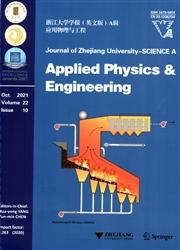Influence of groundwater level changes on the seismic response of geosynthetic-reinforced soil retaining walls
IF 3.9
3区 工程技术
Q1 ENGINEERING, MULTIDISCIPLINARY
引用次数: 1
Abstract
Geosynthetic-reinforced soil retaining walls (GSRWs) have been widely used in civil engineering projects. However, as the climate changes, extreme weather conditions and natural hazards are likely to become more frequent or intense, posing a huge threat to the stability of GSRWs. In this paper, the effect of groundwater level fluctuations on the seismic response of GSRWs is investigated. First, a dynamic numerical model was established and validated through centrifugal shaking-table test results. Using the established numerical model, the seismic response of GSRWs under four different groundwater level conditions was then investigated, i.e., an earthquake occurring at a low groundwater level (Case LW), an earthquake occurring when the groundwater level rises (Case RW), an earthquake occurring at a high groundwater level (Case HW), and an earthquake occurring when the groundwater level drops (Case DW). The results show that the GSRW in Case DW has the worst seismic stability because of the drag forces generated by the water flowing to the outside of the GSRW. For Case RW, deformation of the GSRW under earthquake forces was prevented by the drag forces generated by the water flowing to the inside of the GSRW and the water pressure acting on the outside of the facing, giving the GSRW the best seismic stability in this case. Compared with Case LW, the seismic stability of a GSRW in Case HW is worse, because the high groundwater level will generate excess pore-water pressure during an earthquake. On this basis, we provide engineering design suggestions to be considered by practitioners.地下水位变化对土工加筋土挡土墙地震响应的影响
土工合成加筋土挡土墙在土木工程中得到了广泛的应用。然而,随着气候的变化,极端天气条件和自然灾害可能变得更加频繁或强烈,对地源性轻轨的稳定性构成巨大威胁。本文研究了地下水位波动对地震动墙地震响应的影响。首先,建立了动态数值模型,并通过离心振动台试验结果进行了验证。利用所建立的数值模型,研究了地下水位低时地震(Case LW)、地下水位上升时地震(Case RW)、地下水位高时地震(Case HW)和地下水位下降时地震(Case DW) 4种不同地下水位条件下的地震响应。结果表明,在DW情况下,由于水流向GSRW外部产生的阻力,GSRW的地震稳定性最差。对于Case RW, GSRW在地震力作用下的变形被流入GSRW内部的水和作用在面板外部的水压所产生的阻力所阻止,使得GSRW在这种情况下具有最佳的地震稳定性。与Case LW相比,Case HW的GSRW的地震稳定性更差,因为在地震过程中较高的地下水位会产生超孔隙水压力。在此基础上,提出工程设计建议,供从业人员参考。
本文章由计算机程序翻译,如有差异,请以英文原文为准。
求助全文
约1分钟内获得全文
求助全文
来源期刊

Journal of Zhejiang University-SCIENCE A
工程技术-工程:综合
CiteScore
5.60
自引率
12.50%
发文量
2964
审稿时长
2.9 months
期刊介绍:
Journal of Zhejiang University SCIENCE A covers research in Applied Physics, Mechanical and Civil Engineering, Environmental Science and Energy, Materials Science and Chemical Engineering, etc.
 求助内容:
求助内容: 应助结果提醒方式:
应助结果提醒方式:


